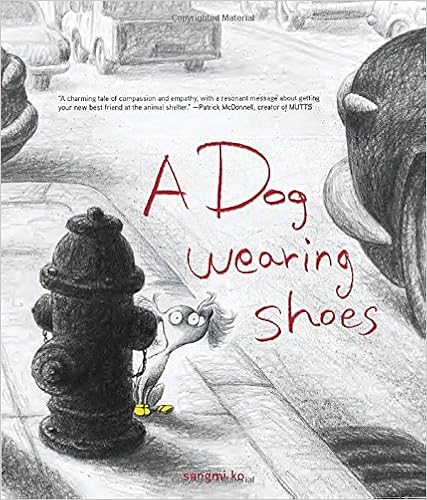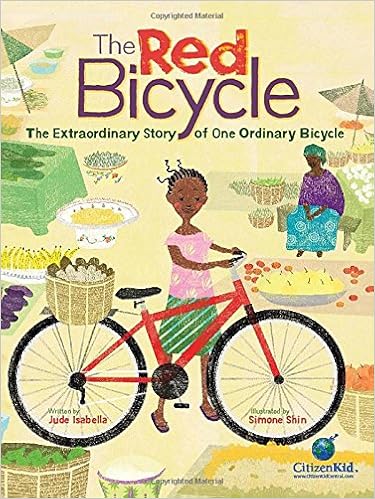It’s Monday! What
Are You Reading? is a community of bloggers who link up to share what they are
reading. For more information check out
the host blogs: Teach Mentor Texts and Unleashing Readers.
What I Read This Week…
A Dog Wearing Shoes by Sangmi Ko
Mini finds a dog and, although she knows he belongs to someone because he is wearing shoes, she wants to keep him. When the dog runs away one day, Mini realizes that his owner must be missing him. When Mini finds the dog's owner she happily returns him and then adopts her own dog. There is a message about empathy within the book. The author also includes an end page in the book in which she advocates for shelter dog adoption. The illustrations which are mostly black and white, with exceptions such as the dog's bright yellow shoes, help to give the story humor and charm.
Dear Yeti by James Kwan
This is a sweet
tale of a wilderness, winter-time adventure.
The story is mostly told through letters that two young hikers send,
with the help of a bird, to yeti as they try to find him and convince him to
show himself. Yeti proves to be a true
friend when the hikers are face-to-face with a grizzly bear. The text is brief, but the illustrations are
adorable and the message is heart-warming.
I Don't Like Koala by Sean Ferrell
This is a funny story of a creepy stuffed animal and the boy who just can't get rid of him. Adam attempts to hide him and run away from him, but the stuffed koala, "who has terrible eyes that follow him everywhere" keeps turning up. Adam's attitude changes when he realizes that koala's watchful eyes may actually do some good. The illustrations show a stuffed koala who is both creepy and cute.Meet the Dullards by Sara Pennypacker
Mr. and Mrs. Dullard are dull and they want to keep it that way, so when their children shock them by doing things that are not dull, such as reading and playing outside they decide to move. The book has humor and word play: the Dullard children are named Blanda, Borely, and Little Dud; the children sit and watch the television to calm down although it is unplugged; the ice cream stand has 90,000 flavors but the Dullards order vanilla cones without the cones or the vanilla. The dullness of the Dullards is greatly exaggerated which may make anyone who thinks their life is boring reconsider.The Red Bicycle: The Extraordinary Story of One Ordinary Bicycle by Jude Isabella
When Leo outgrows
his bicycle, Big Red, he donates it to an organization that collects used
bicycles and sends them to countries where they are needed for transportation,
but people can’t afford them. The book
tells the story of how the bike makes a difference in the lives of others
living in a country in West Africa. At
the end of the book, the author provides additional information about
organizations that collect bikes for those in need. This story shows the global impact that one
person can make and will provide inspiration for those who want to help
others.
When Santa Was a Baby by Linda Bailey
This is a picture
book that will satisfy the curious mind of anyone who would like to know what
Santa was like as a child. The book
tells about aspects of Santa’s childhood that mirror what he is like as an
adult. There is his booming voice even
as a baby, his affinity for red, chimneys, and cold temperatures, his
generosity, and his pet hamsters which he harnessed with ribbon to a
matchbox. I think the illustrations are
what I like best about the book. They
look old-fashioned and remind me of the Golden Books I read as a child. Baby Santa is without pants in a couple of
pictures which is sure to make children giggle.
The Ghost Backstage (The Haunted Library #3) by Dori Hillestad Butler
This book is part of an early reader chapter book series. There is a ghost who has been separated from his family, a girl named Claire who can see and talk to ghosts, and a mystery concerning ghostly happenings at Claire's school. The plot is simple, but it's hooked the interest of many of my readers who enjoy the mystery and the fantasy within the story.
Dino-Mike and the Underwater Dinosaurs by Franco
This is the third book in a chapter book series. The book is short with illustrations on every few pages so it would be appealing to younger readers who are just beginning to transition to chapter books or don’t have the stamina for longer texts. Young readers will appreciate the action and adventure, especially those who like dinosaurs. The main character in the series accompanies his paleontologist dad on fossil hunting trips, but has his own experiences with real dinosaurs.Never Girls #1: In a Blink by Kiki Thorpe
Recently, I was asked by parent if I knew of any books about fairies that, in her words, "were not lame." She explained that her child only wants to read books about fairies and had already gone through one book series. After some searching, this is the series I found. This chapter book series, by Disney, is written for 6-10 year olds. In the book, four girls are transported to Pixie Hollow, a land of fairies, which for them is like a magical, marvelous dream. Readers who are fans of fairytales and magic will be transported along with the girls to an imaginative land and enjoy the girls' adventures.
The Tapper Twins Go To War (With Each Other) by Geoff Rodkey
This is the first
in a middle grades chapter book series about twins who are also rivals. In this book the twins are at war and they each
try to play the biggest and best prank on the other. The book is written in a unique way as it’s
told from the perspective of the twins as they alternate telling their account
of what happened and includes text messages, photographs, and chat logs to tell
the story. The storyline is meant to be
silly and humorous, but some may feel this is a book for the upper end of the
middle grades due to the topic and the nature of the sibling rivalry.














